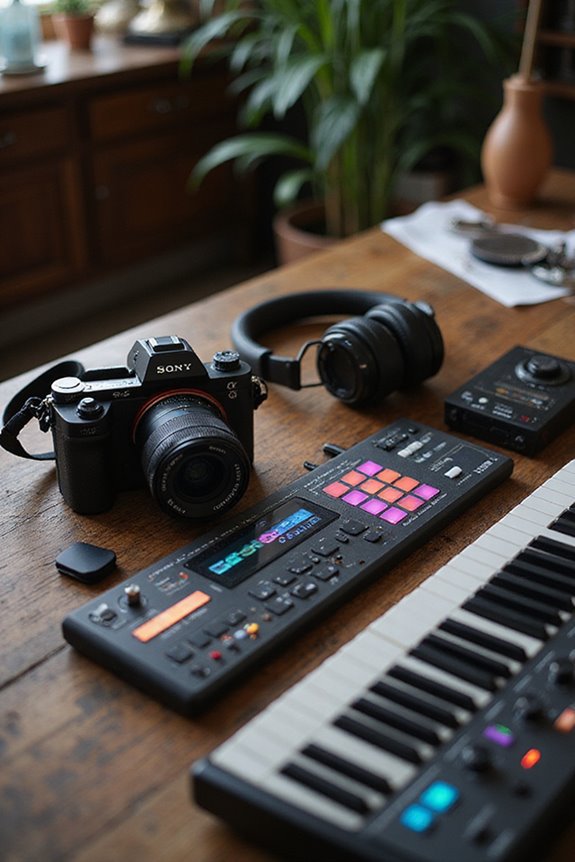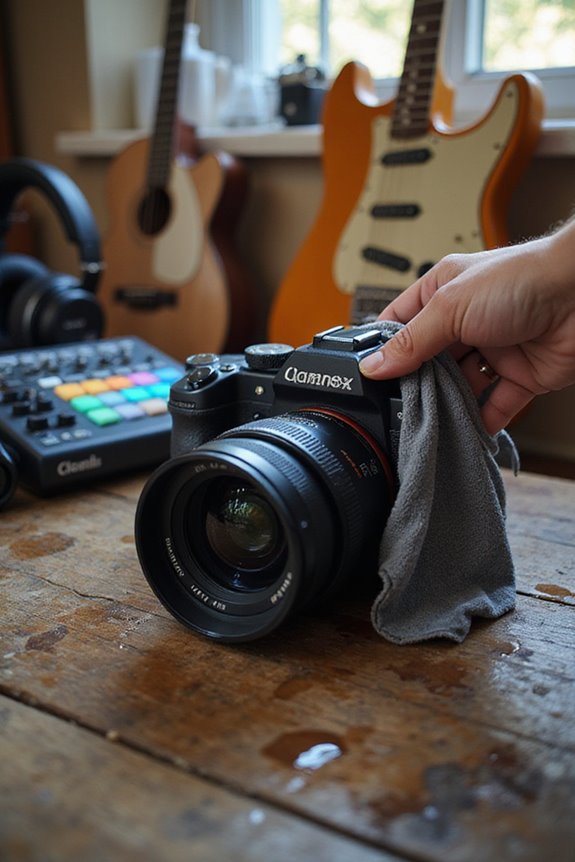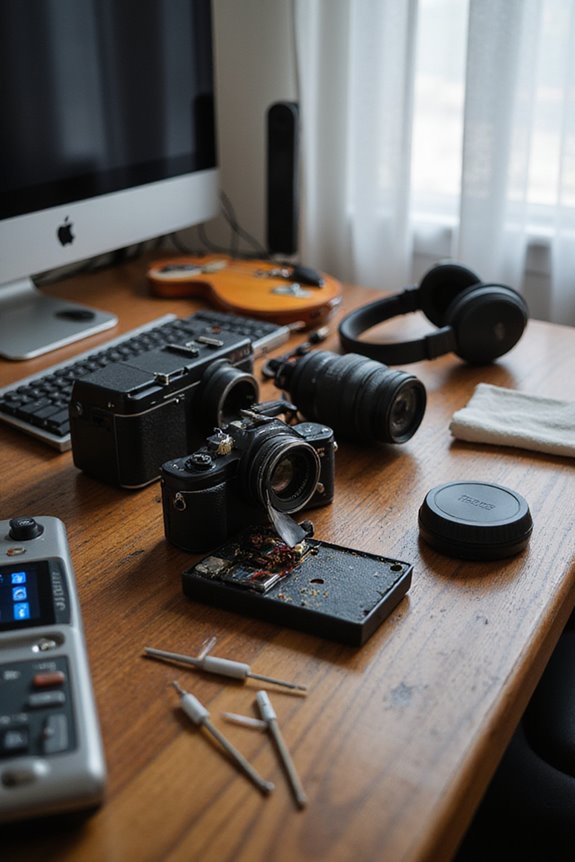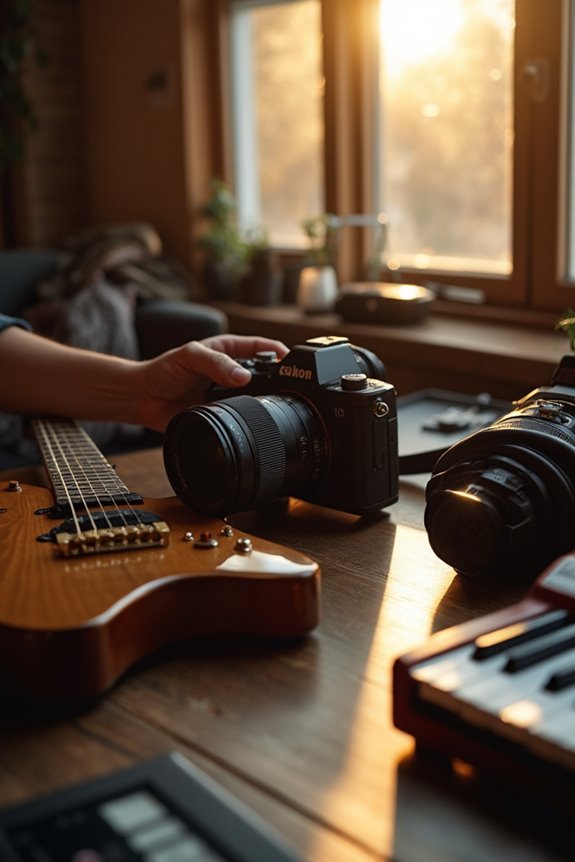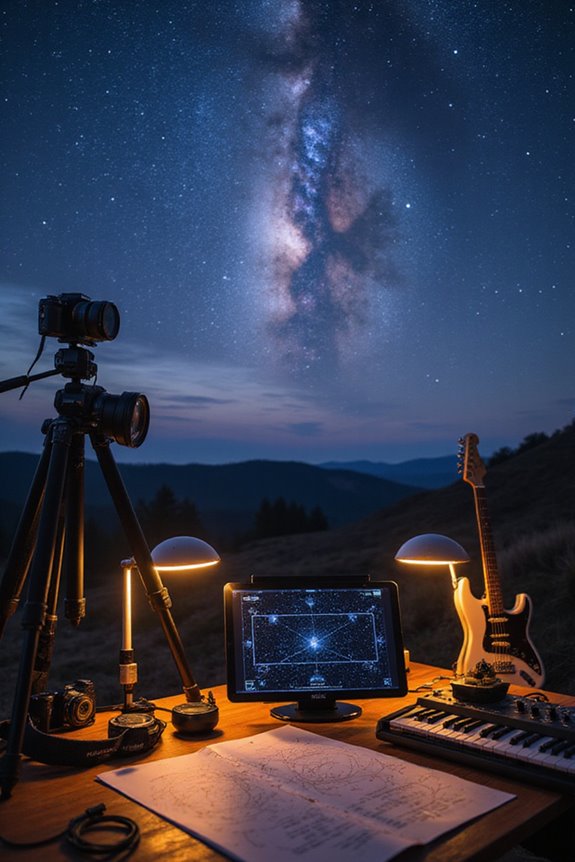To capture stunning abstract photography, we should master essential camera settings tailored to our creative vision. Start with Manual Mode for full control over aperture, shutter speed, and ISO. Use slow shutter speeds for intentional motion blur and larger apertures like f/1.4 for beautiful bokeh. Adjust ISO based on light conditions, keeping it low in bright settings to reduce noise. With a focus on lighting and composition, we can enhance textures and shapes in our images. Let’s explore more techniques together!
Key Takeaways
- Use Manual Mode (M) for complete control over aperture, ISO, and shutter speed to create unique abstract effects.
- Experiment with slow shutter speeds to introduce intentional motion blur, adding a dynamic element to compositions.
- Select larger apertures (e.g., f/1.4) to achieve beautiful bokeh and isolate subjects from distracting backgrounds.
- Adjust ISO settings based on lighting conditions; lower ISO (100) for bright scenes and higher ISO for low light to maintain image quality.
- Utilize multiple exposure mode to layer images and create intriguing textures and color combinations in your abstract photography.
Camera Modes for Abstract Photography
When it comes to diving into abstract photography, understanding camera modes is essential, as they greatly influence our creative outcomes. Using Manual Mode (M), we can fine-tune aperture, ISO, and shutter speed, giving us complete control for those detailed abstract techniques. Aperture Priority Mode (A or Av) is fantastic for achieving beautiful bokeh, letting the camera handle shutter speed while we focus on depth. For quick experimentation, Program Mode (P) strikes a balance between automation and manual adjustments. Finally, Multiple Exposure Mode enables us to layer images, merging textures and colors for unique visuals. With these camera modes, we can truly explore the depths of abstraction and enhance our photography artistry.
Shutter Speed Settings
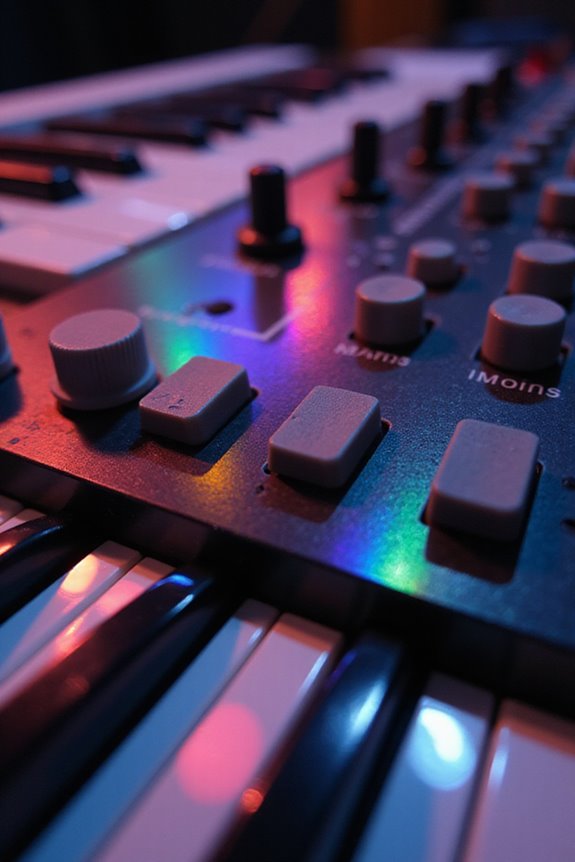
To truly understand the impact of shutter speed in abstract photography, we need to recognize its fundamental role in controlling light exposure and motion. A fast shutter speed, like 1/1000 sec, freezes action, perfect for capturing sharp images of dancers or athletes. In contrast, slower speeds, such as 1/10 sec, invite intentional motion blur, creating artistic trails in your photos. For stationary subjects, a shutter speed of 1/60 sec is usually sufficient. As we capture flowing movements or textures, remember that slower speeds can emphasize that fluidity. Using a tripod for slower settings can prevent unintended blur, enhancing image quality while achieving striking abstract effects. Ultimately, our shutter speed choices dramatically shape our creative vision.
Aperture Settings and Depth of Field
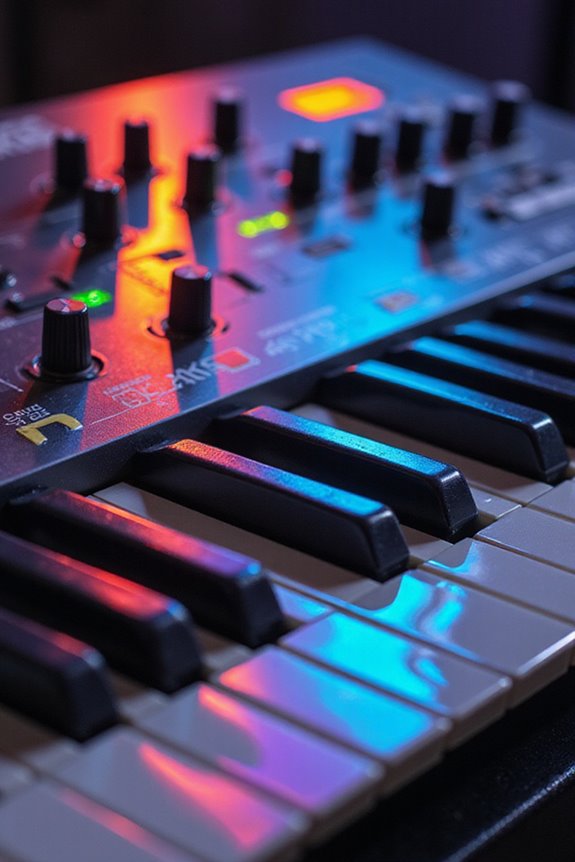
Understanding aperture settings is essential for shaping our creative vision in abstract photography. Our choice of aperture directly influences both exposure and depth perception. Larger apertures, like f/1.4, create beautiful bokeh and isolate our subjects, enhancing the strong aperture effects that we enjoy in our work. This shallow depth of field blurs distracting elements and draws the viewer’s eye precisely where we want it.
Conversely, smaller apertures, such as f/16, offer greater detail across the frame, making them ideal for landscapes and architecture. When balancing between desired depth of field and exposure, we can creatively manipulate our images to achieve striking and expressive results, tailoring our approach to the specific characteristics of each scene.
ISO and Sensitivity Control
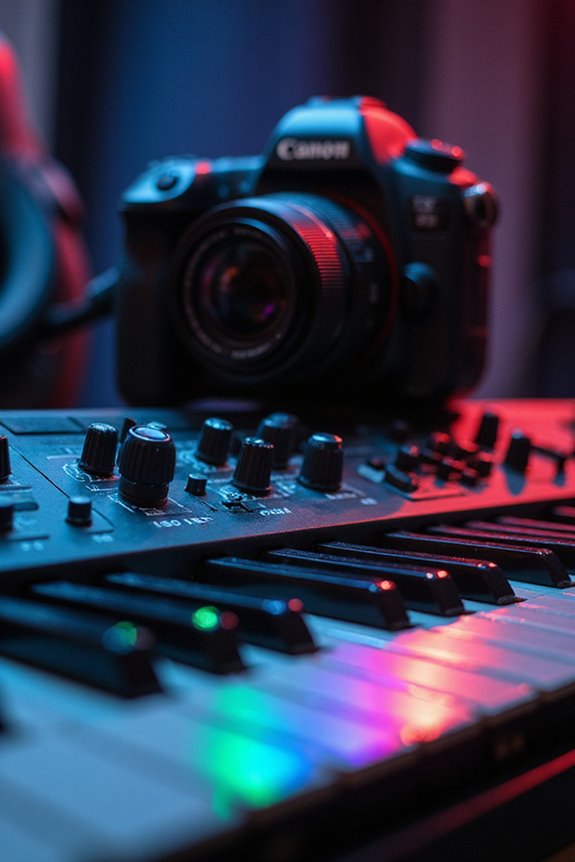
As we plunge into the domain of ISO and sensitivity control, it’s essential to recognize how these settings can transform our abstract photography. ISO adjustments directly affect our camera sensor’s sensitivity to light, allowing us to strike the right balance for various conditions. For example, we might use ISO 100 in bright daylight for sharp images with minimal noise. Conversely, in lower light, cranking up to ISO 1600 can brighten our shots, but we also risk introducing graininess.
Effective noise management is key here; higher ISO typically increases noise, which can undermine our artistic vision. By mastering these settings, we can confidently capture stunning abstract images while maintaining quality in every shot.
Lighting and Contrast Techniques
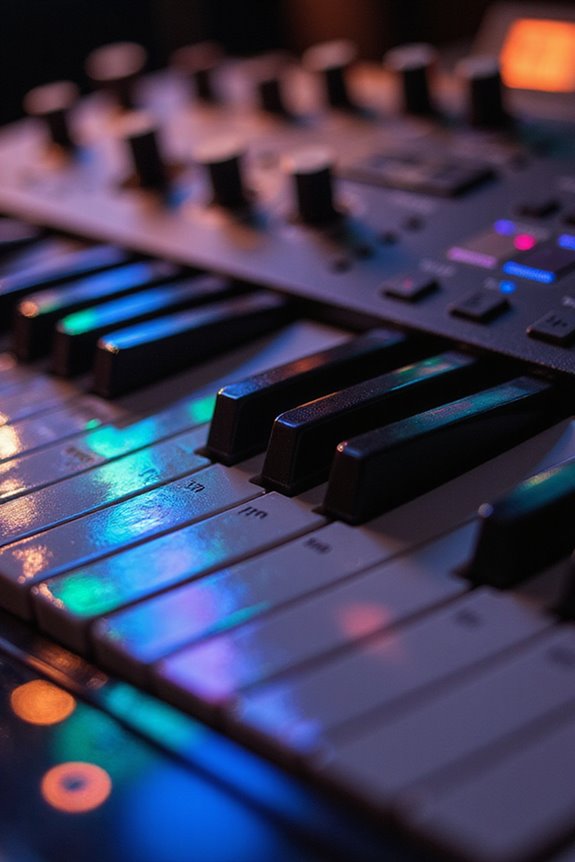
Lighting and contrast techniques play an essential role in shaping the mood and detail of our abstract photography. By mastering light manipulation, we can create striking images. For instance, using side lighting enhances textures, while backlighting casts dramatic silhouettes. Top lighting, on the other hand, flattens surfaces ideal for minimalism.
Contrast control is equally critical; employing high-contrast lighting can accentuate edges for dramatic tension. We can utilize polarizing filters to enhance color contrasts and adjust our exposure settings for deeper shadows. Experimenting with shadows and highlights further adds complexity to our abstracts. Creative methods, like light painting, allow us to explore vibrant patterns. Additionally, using adjustable color temperatures can help us achieve the perfect ambiance for our scenes. Let’s harness these techniques for powerful and enchanting visuals!
Composition and Perspective Settings
Composition and perspective settings are fundamental to abstract photography, allowing us to transform ordinary scenes into extraordinary visual statements. By experimenting with unusual angles—overhead, low, or side views—we’re able to capture unique shapes and isolate patterns. Framing techniques like extreme close-ups can abstract everyday objects, drawing focus on their texture without context.
Tilt the camera to introduce diagonal lines, creating dynamic tension. Additionally, zooming out can reveal broader scenes and spatial abstractions. Incorporating reflections can further enhance perspective distortion, adding layers of complexity. Remember, a well-composed image balances positive and negative space, guiding the viewer’s eye through the abstraction. Let’s embrace these techniques to craft compelling compositions that celebrate the beauty in simplicity. Moreover, understanding image quality and sensor performance can elevate our abstract photography, ensuring that the details and textures we capture are rendered with clarity and depth.
Utilizing Long Exposures
Utilizing long exposures in abstract photography can dramatically transform our images and elevate their visual impact. By capturing light over extended periods, this technique reveals movement invisible to the naked eye, resulting in mesmerizing motion blurs and ethereal forms.
To achieve this, we can use a slow shutter speed—often several seconds or more—allowing us to picture subjects like rolling waves or swaying trees with a dreamlike quality. Using a sturdy tripod and ND filters, we can guarantee sharper static elements while experiencing longer exposures even in bright conditions.
Additionally, experimenting with intentional camera movement during the shot can create stunning abstract effects, enhancing the overall artistic expression in our work.
Experimentation and Creativity in Abstract Photography
While diving into abstract photography, we quickly discover that pushing boundaries and experimenting is essential for developing our unique style. Creative exploration begins with techniques like intentional camera movement (ICM), where we can dramatically blur our subjects, introducing a sense of fluidity and dynamism. By utilizing slower shutter speeds, we amplify motion and reveal unexpected nuances in even the simplest scenes.
Furthermore, engaging in multiple exposures opens avenues for layering and depth, allowing us to tell complex visual stories. Combining images through digital manipulation can yield striking variations of familiar subjects. Ultimately, it’s this dynamic experimentation that fuels our journey, providing unlimited opportunities for personal expression and innovative art. Let’s embrace the process and see where it leads us!
Tips for Capturing Abstract Textures and Patterns
When we commence the journey of capturing abstract textures and patterns, attention to detail in our camera settings can make a significant difference in the final outcome. First, increasing contrast enhances texture details, bringing them to the forefront of our images. We should also consider using sharpening techniques to reveal fine elements that might otherwise remain hidden.
When selecting colors, vivid tones will emphasize patterns, while monochrome can highlight texture more effectively. Experimenting with side lighting helps us uncover surface irregularities, while macro lenses allow for detailed captures of small-scale features. Additionally, investing in a high-speed memory card with UHS Class 3 ratings can ensure that the images are stored quickly and efficiently. Finally, post-processing adjustments guarantee we refine contrast and sharpen texture details, enhancing the overall impact of our compositions while maintaining a natural feel.
Frequently Asked Questions
What Kind of Camera Is Best for Abstract Photography?
When choosing a camera for abstract photography, we find mirrorless cameras ideal for their lightweight design and advanced features. Film cameras can also offer unique textures, depending on the artistic vision we’re aiming to achieve.
How Do Lens Choice and Focal Length Impact Abstraction?
Let’s explore delightful dynamics! Our lens choice and focal manipulation dramatically affect abstraction; wide-angle creates expansive effects while telephoto introduces lens distortion, altering depth perception. Each option invites unique perspectives that transform our visual storytelling.
Can Smartphone Cameras Be Effective for Abstract Photography?
Absolutely, smartphone cameras can be effective for abstract photography. By leveraging smartphone features, like macro modes, and employing unique composition techniques, we can capture intriguing images that highlight textures, colors, and shapes in exciting new ways.
How Important Is Post-Processing in Abstract Photography?
We believe post-processing is essential in abstract photography. Using digital manipulation techniques, we can creatively enhance our images, transforming them into unique artworks that capture emotions and ideas beyond what the camera initially captures.
What Are Common Mistakes to Avoid in Abstract Photography?
We’ve all felt that moment of frustration when our art doesn’t match our vision. To avoid common mistakes in abstract photography, let’s focus on composition errors and lighting issues that can dilute our creativity.

